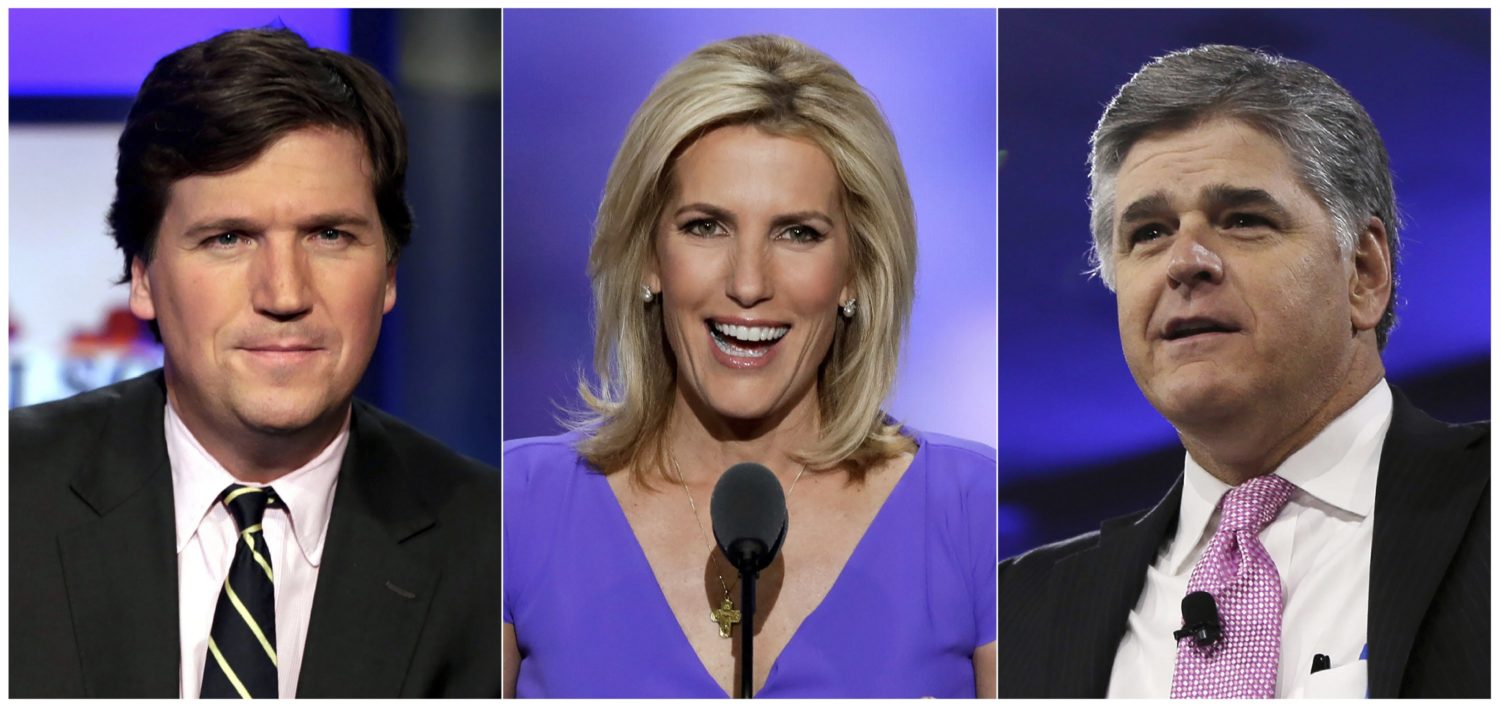The Poynter Report is our daily media newsletter. To have it delivered to your inbox Monday-Friday, click here.
Typically when this country goes through tragedy or hardship, it bands together. Think back to the Sept. 11 terrorist attacks and how the United States pulled together. We’ve also seen examples of solidarity and support after natural disasters like Hurricane Katrina or the Houston floods caused by Hurricane Harvey or any of the annual tornado outbreaks that devastate towns in the Midwest and South. In troubled times, Americans tend to push in the same direction.
The coronavirus story, however, has been different. Yes, there is a sense of we’re-all-in-this-together because we have this shared experience of staying at home. And, for far too many, there’s the shared grief of losing a loved one and the shared stress of losing a job.
But there also is a clear divide in this country, too. It centers on how we believe we got here and where we go from here. It is mostly down party lines. And examples can be seen in how people are consuming their news.
Consider this: Fox News has never been more popular. The network is setting records.
April produced the best primetime numbers in the history of Fox News, with an average viewership of 3.68 million. Let me repeat that: the most-watched primetime month in Fox News history.
Not only was that the most-watched primetime month since the network debuted in 1996, it’s a 54% jump over a year ago. All three of its primetime shows — led by Tucker Carlson, Sean Hannity and Laura Ingraham — are individually seeing some of the best numbers they’ve ever seen.
As far as total day viewers, Fox News’ average of 2.2 million in April is the second-best month ever, surpassed only by April 2003 when Fox News was covering the early stages of the Iraq War. Bret Baier’s show, boosted by the White House coronavirus press briefings, pulled in 5.3 million total viewers — best on all of cable news for April.
The point: These are huge numbers for, let’s face it, a network that often is supportive of President Donald Trump, his ideas and the Republican Party. Fox News’ primetime hosts are fiercely loyal to the president and it says something that those hosts are delivering the biggest audiences in the history of the network.
Then again, if you believe that CNN and MSNBC — and I’m talking primarily in primetime — lean to the left, those numbers are huge, too. In fact, combined, they pretty much run right alongside Fox News.
Take April primetime viewers. If you were to add up MSNBC (2.03 million) and CNN (1.94 million), you get 3.98 million viewers, or about 305,000 more than Fox News. That’s pretty much a wash.
Same with average viewership in total day viewers. Add up CNN (1.36 million) and MSNBC (1.248), and you get 2.64 million, or about 407,000 more than Fox News.
The thing that stands out about all of this is the cable news networks have rarely seen these kinds of numbers. While Fox News is drawing record numbers, so is MSNBC’s “Morning Joe,” which is typically highly critical of Trump. April was its best viewership month.
So what does this all mean? Never have citizens been watching the news more closely and, one could reasonably assume based on the well-earned reputations of those networks, never have those citizens been more divided.
In a word: no
Fox News’ Sean Hannity got the brushoff Tuesday from The New York Times. Hannity hired attorney Charles Harder — the lawyer best known for the Hulk Hogan case that took down Gawker — to get a retraction and apology from the Times over columns criticizing Hannity. One of the columns in question was an April 18 column by Ginia Bellafante that quoted a woman who said her father died from the coronavirus and that he might have dismissed the dangers of the virus because of his steady diet of Fox News.
Bellafante wrote, “Early in March Sean Hannity went on air proclaiming that he didn’t like the way that the American people were getting scared ‘unnecessarily.’”
That was just one of the columns Hannity didn’t like.
In a rather dismissive response to a letter from Harder, the Times said — in a word — to not expect either a retraction or an apology.
Through newsroom attorney David E. McGraw, the Times also took a shot at Harder’s rather lengthy letter in their response:
“I write in response to your 12-page letter alleging that your client Sean Hannity was defamed by three columns in The New York Times.
“The columns are accurate, do not reasonably imply what you and Mr. Hannity allege they do, and constitute protected opinion.
“In response to your request for an apology and retraction, our answer is ‘no.’”
[the_ad id=”667826″]
A media criticism from a media critic
In her latest piece, Washington Post media columnist Margaret Sullivan says the media is getting better at covering President Trump, but that history will not judge the media kindly, especially when it comes to covering Trump and the coronavirus.
“ … the coverage, overall, has been deeply flawed,” Sullivan wrote.
Her criticism: “We normalize far too much, offering deference to the office he occupies and a benefit of the doubt that is a vestige of the dignified norms of presidencies past. And day after day, we allow him to beat us up. And then we come back for more.”
As always, Sullivan’s column is a thought-provoking read, although I’m not sure I agree with some of her premise. She’s right when she says Trump’s outrageous claims and comments can distract us all from the truly critical stories.
But, Trump’s “un-presidential” behavior (my words, not Sullivan’s) has not been normalized by much of the media and he does not get the benefit of the doubt by many who cover him. In fact, media outlets have become bolder in their criticism and pushback of Trump, including Sullivan’s own paper.
Certainly, Trump supporters — which includes part of the media (read: Fox News primetime) — praise Trump’s media attacks and his against-the-norm behavior. That behavior and attitude, unlike what we’re used to seeing, are why many voted for him and continue to have unwavering support for him.
Sometimes, the media has no choice but to cover the president, including what he says and what he does. Responsible journalists then follow up with fact checks, context and even criticism for what many feel is abnormal, inappropriate or ineffective behavior, and how all that could impact Americans. But does covering the president sometimes mean HIS message gets across? Sullivan wonders how we will look back at this coverage years from now.
Sullivan writes, “When we have that distance, what I suspect we’ll see is a candidate and a president who played the media like a puppet while deeply damaging the public’s trust in the press as a democratic institution. Someone who dazzled us with his show, while acting constantly in his own self-interest while we willingly — almost helplessly — magnified his message.”
Staying on the story

NBC News’ Vaughn Hillyard reporting on the “County to County” election project. (Courtesy: NBC Universal)
Last November, NBC News launched something called “County to County.” It was scheduled to be a yearlong project leading up to the 2020 election. The idea was to focus on counties in five battleground states likely to play critical roles in the election: Milwaukee County (Wisconsin), Beaver County (Pennsylvania), Kent County (Michigan), Maricopa County (Arizona) and Miami-Dade County (Florida).
Well, the coronavirus pandemic has not stopped the project. Reporter Vaughn Hillyard’s latest report checks in on those five counties as they deal with the same things all of us are dealing with — life during the time of coronavirus. In addition, Dante Chinni’s companion piece breaks down the number of coronavirus cases and deaths in those five counties.
Chinni’s piece shows the harsh health and economic impacts being felt in those counties. For example, Kent County in Michigan has been hit especially hard, with 906 confirmed coronavirus cases (that’s 139 per 100,000) and 29 deaths and data that suggests the spike is still coming. In addition, unemployment has jumped 2.4% since February. These are the kinds of numbers that could have an impact in November.
[the_ad id=”667872″]
Pot and kettle
Poynter’s Kristen Hare and Ren LaForme have been all over the Gannett layoffs in recent days.
Meanwhile, the New York Post’s Keith J. Kelly writes not only about the layoffs, but that photographers at Gannett are complaining about not having suitable protective equipment when they go out on assignments.
Speaking of the New York Post, the paper has written plenty about job cuts and furloughs at other news outlets, but there has been little reporting of furloughs at the Post itself.
Post NBA writer Brian Lewis tweeted last week that he has been furloughed. No word on the number of furloughs and for how long, but sources told Poynter that it could involve 20% of the newsroom and the furloughs could be 60 to 90 days, and possibly longer. Post editor-in-chief Stephen Lynch did not respond to a request for comment.
Return of The Ocho
ESPN is bringing back ESPN8, otherwise known as The Ocho — the channel based on the fictional network from the 2004 movie “Dodgeball: A True Underdog Story.” For the second time since sports have been shut down, ESPN will run a day’s worth of offbeat sports. The Ocho will run on the regular ESPN this Saturday from noon to 11 p.m. Eastern.
Sports featured on this version of The Ocho include marbles, cherry pit spitting, stupid robot fighting, sign spinning, arm wrestling, lawn mower racing, stone skipping and much more.
Hot type
- The City’s Ese Olumhense with “A Pregnant Woman Tweeted Concerns About a Bronx Hospital. She Died Days Later.”
- Forbes’ Simon Chandler writes about the links between “reopen America” protests and gun advocacy groups, lobbyists and various conservative organizations.
- Will the McClatchy newspaper chain be sold? Poynter media business analyst Rick Edmonds has the details.
- Axios, which had qualified for the Paycheck Protection Program, will return the money. CEO Jim VandeHei explains why.
- The Poynter-owned Tampa Bay Times produced a video from its journalists talking about the work it is doing during coronavirus. And executive editor Mark Katches wrote a column about how readers and the paper are adjusting.
Have feedback or a tip? Email Poynter senior media writer Tom Jones at tjones@poynter.org.
[the_ad id=”667878″]
More resources for journalists
- On Poynt Live training: April 30 at 2 p.m. Eastern — Job-Hunting During a Pandemic: How to Make Yourself the Best Candidate — Poynter
- Bring Poynter to Your Newsroom, Classroom or Workplace
- Evaluating Evidence In Solutions During A Pandemic: April 29 at 11 a.m. Eastern— Solutions Journalism Network
- Covering Coronavirus: How to be an antiracist, May 4 at 11:30 a.m. Eastern — Journalism Institute, National Press Club
Want to get this briefing in your inbox? Sign up here.










There are several things wrong with this story. First is the assumption that Fox anchors like Bret Baer and Chris Wallace are in the tank for Trump. This is clearly not the case, as both are well respected and have a history of asking very tough questions of both sides.
Second, is the unthinking assumption _that every other outlet is being fair in their coverage_ . This is manifestly not the case. I have been a journalist for nearly 30 years and I have never seen such reflexive hatred of a sitting president. Nor have I seen such a blatant abandonment of basic ethics in the pursuit of said hatred. I have seen journalists excuse their obvious bias as “well, he’s not like any other president so we have to treat him differently.”
Au Contraire. I didn’t vote for the man, don’t personally like him. But it is our DUTY as journalists to not only put that aside, but RECOGNIZE our bias and therefore go the extra mile to be fair in our reporting.
That so many journalists, and particularly Poynter, see no need to do so, and to publish blatantly biased “reporting” such as this, explains why we are held in such low esteem by so much of the public.
What’s truly sad, is that the profession I love, and to which I have devoted my entire life, can’t see what they are doing. The basic objectivity, that is supposed to apply EVEN TO OURSELVES, is completely gone. We are not even attempting to examine our own biases, in light of our coverage. Instead, so-called journalists are rationalizing their blatant preference for one side over another with “because Trump.”